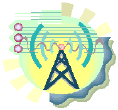Welcome to Handiham World.
The temptation of power!

What is it about power that makes some people crazy for it? Once they have a taste of power, they want still more.
Of course in ham radio, the idea of more power is usually associated with operating with higher power output by adding RF amplifiers. If 100 watts is good, 1,000 must be better, right?
Wrong!
What does the FCC say? It's §97.313, Transmitter power standards. Section (a) says, "An amateur station must use the minimum transmitter power necessary to carry out the desired communications."
There are good reasons for using lower power levels most of the time. If the other station can hear you when you are using 100 watts, you are only wasting electricity to run more power than that. We are more conscious about waste these days, since power costs are going up and the generation of that wasted power wastes resources and causes pollution. Furthermore, that unnecessary power can cause your signal to be heard on adjacent frequencies and at long distances. A high-power station can easily cause interference to other users on the band, but there is also a much greater chance of RF getting into nearby conductors where it causes bad things to happen.
I remember a Handiham member who moved into an apartment and was lucky enough to be able to have a wire antenna installed on the roof of the building. Back in those days, we were able to field volunteers to help members with such projects, and our volunteer was able to install and connect the antenna. The fellow had moved from a private single-family house where he had owned and operated a complete, well-equipped station that included a linear amplifier for the HF bands. Our volunteer explained to him that the amplifier would not be practical in the new QTH, since there was not enough real estate to get the wire antenna well away from the building. The linear was stored in a closet, and the station was tested on the air with good results.
Well, you can probably guess what happened. The station's owner was used to operating with high power. (Remember: the thinking was, "If some is good, more is better.) So out came the linear from the closet and back into the ham shack it went. It wasn't long before we got a call with the bad news that the poor fellow had lost his ham radio privileges at his new QTH after setting off all the fire alarms in the building. I don't know if he was ever able to get on the air after that. It was before the days of remote base internet operation, so he was probably stuck on whatever VHF repeaters he could work from his apartment.
Adding a linear can put enough RF energy into the area surrounding your shack to affect your neighbors, too, even if you live in a detached single-family home. Devices like audio amplifiers can be connected to speakers systems in home theaters by long lengths of unshielded wire. The final output ICs in these devices can act as rectifiers to demodulate the RF and cause loud thumping noises in the speakers. Other devices that may be connected to long lengths of wire are alarm systems, intercoms, and smoke detectors. The relatively weak field from a 100 watt station might occasionally affect something in one's own home, but is seldom a problem next door. Bump the power up to 1,000 watts and you are asking for trouble.
Another consideration is the need for an RF safety audit. Generally speaking, you don't have too much to worry about when using the typical transceiver without an amplifier. When you increase power levels beyond that 100 watts you are going to need to "run the numbers" to make sure that you are in compliance with RF safety rules. For example, if you are using 100 watts on 29 MHz with a dipole antenna, you will be in full compliance at a distance of 25 feet from the antenna for both controlled and uncontrolled space. However, if you use 1,000 watts and the same antenna, you are out of compliance for uncontrolled space. If a neighbor's property is within that 25 feet, you are now operating outside regulations and exceeding safe power levels. It is even worse if you have a beam antenna for 10 meters because of the antenna gain, which could increase the RF exposure even more in the uncontrolled space. It goes without saying that you want to keep RF exposure to yourself, your family, and your neighbors to safe levels. It is much easier to do this at lower power levels.
My favorite reason to stick to lower power levels is that linear amplifiers only give your transmitted signal a boost. They do nothing at all to help you receive weak signals. In fact, calling CQ with your linear turned on can lead to responses from stations that are too weak to copy. You can get more bang for your buck by installing a better antenna system. Once I learned this for myself, I have advised new hams to concentrate on good, effective antennas instead of amplifiers. After all, the antenna system will help pull in those weak signals, helping you both on receive and transmit.
There is a time and a place for turning on the amplifier. It is when band conditions are deteriorating and more power might help you complete the QSO. It might be when you are the net control station on an HF net and it is necessary to use high power to make sure that you are heard throughout the geographic area of the net. It is probably going to be helpful in the summer when there is thunderstorm static and you are operating on 75 meters. But more often than not high power is really not necessary. Let's not use it if we don't need it.
For Handiham World, I'm...